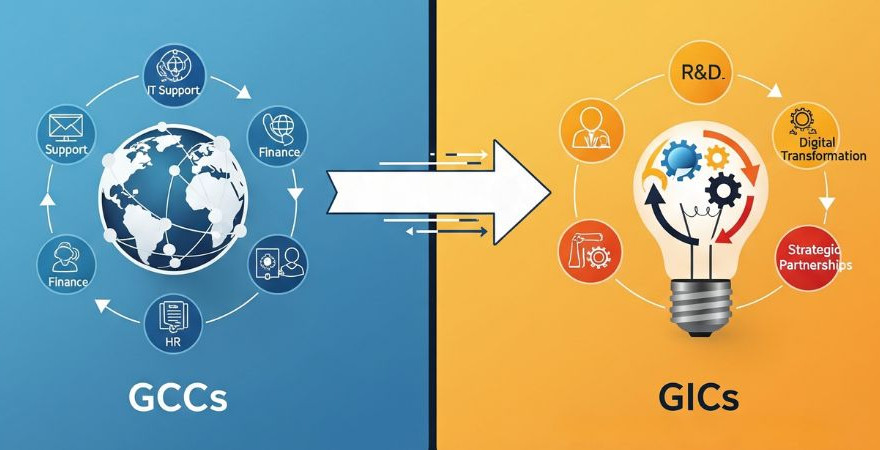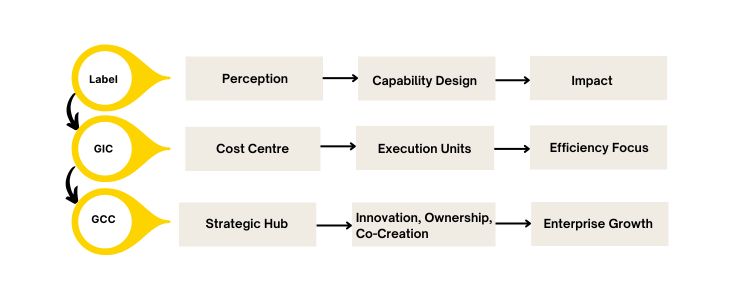
Even in 2025, India will remain the center of technology and innovation distribution in the world. Over 1,900 global capability center (GCC) are already employed in the country and are contributing around 64 billion US dollars. The terminology that defines these centers is no longer just semantic. Those who were once called the Global In-House Centre (GIC) are now rapidly being branded as global capability centers or global innovation centers, indicating a major change in commercial priorities. As a leading GCC service provider in India, we have seen this change not only in naming but also in purpose, impact, and price distribution. This blog throws light on this: Is the change from GCC to GCC more than just branding? Does this reflect a change in global business strategy?
Previously, GIC was seen as “captive,” low-cost, skilled units that focused on support functions. But today’s GCCs are at the center of enterprise-wide change, which is responsible for creating a platform prepared for the future, implementing AI and enabling full-stack engineering.
This vocabulary change from GIC to GCC is inspired by the development of commercial guides for these centers. The 2024 Nascom-Everest Group report shows that: These reflect a fundamental change in strategic priorities: transactional execution to innovation ownership.
As a GCC Consultation and Advisory firm, we are getting clear indications from the market:
India provides an ideal ecosystem for GCC to GIC transformation: The combination of intensive talent, favourable economics, and policy speeds makes India a natural center to develop from GIC to GCC.
Steps towards global in-house centers to global capability centers are not only symbolic, but they also show how companies are restoring India as a price creation engine. In the near future, words such as “global product headquarters” or “digital nerve center” may emerge. The most important thing is how these centers have strategic impacts in global markets.
Changes from GIC to GCC are much more than a linguistic update. It reflects a fundamental change in global enterprise strategy. As organisations evolve in innovative ecosystems from efficiency-operated models, the vocabulary they adopt reveals their aspirations and intentions. In India, this development is taking place fast. With the depth of unmatched talent, cost efficiency, and digital maturity, India’s GCC landscape is not only developing; it is giving a new look to global operating models.
For global enterprises, it is necessary to adopt the GCC mindset to be competitive, agile, and prepared for the future. And Inductus GCC indicates it has a deep responsibility: to enable its partners not only to operate in India but also to lead India. In our firm, we help global enterprises to create, expand, and develop their GCC in India so that they can move beyond operating excellence and move towards transformative ability to lead.
GIC (Global in-House Centre) is usually focused on internal operations and cost efficiency, while GCC (Global Capability Centre) is designed to promote innovation, strategic changes, and commercial value. This rebranding is in line with a broader strategic change. Organisations now expect their India centers to lead innovation, develop products, and contribute to global development, not only back-office tasks. Technology, BFSI, healthcare, automotive, and consumer goods are at the forefront of this change, using Indo-based GCC for research and development, product engineering, and digital changes. GCCs attract high-quality digital and engineering talents due to their strategic status and focus on innovation and career development opportunities compared to the GIC. Not necessarily. Some centers, especially in regulated industries or focused on compliance, may retain the GIC label. However, the rising number of centers are turning to the GCC model to reflect the changing mandates. Aditi, with a strong background in forensic science and biotechnology, brings an innovative scientific perspective to her work. Her expertise spans research, analytics, and strategic advisory in consulting and GCC environments. She has published numerous research papers and articles. A versatile writer in both technical and creative domains, Aditi excels at translating complex subjects into compelling insights. Which she aligns seamlessly with consulting, advisory domain, and GCC operations. Her ability to bridge science, business, and storytelling positions her as a strategic thinker who can drive data-informed decision-making.
Understanding the Terminology: GCC vs GIC
Feature
Global In-house Centre (GIC)
Global Capability Centre (GCC)
Primary Role
Internal distribution and back-office operations
Innovation, capability building, value creation
Perception
Cost center
Strategic development engine
Talent center
Process-oriented roles
Product, digital, AI/ML, and GenAI roles
Commercial Strategy Alignment
Efficiency and control
Agility, transformation, customer proximity
Ownership
Centralised governance
Distributed and cross-functional leadership
Why This Shift?
Why is GCC Leading Now?
Strategic Implications of This Change

India's Economic Benefits
What's Next?
Conclusion
frequently asked questions (FAQs)

Aditi
Hey, like this? Why not share it with a buddy?
Related Posts
Recent Blog / Post
- The Legal and Compliance Checklist for a New GCC Setup October 4, 2025
- The Rise of Niche GCCs: A Focus on Specialised Capabilities October 4, 2025
- The Impact of Regulatory Changes on GCC Operations October 4, 2025
- Cybersecurity for GCCs: A Proactive Approach to Data Protection September 30, 2025
- Beyond Cost: Measuring the True ROI of Your GCC Investment September 29, 2025
- The Future of GCCs in the Retail Sector: A Strategic Playbook September 29, 2025
- David vs Goliath: Mid-Sized GCCs Quietly Outperform the Big Brands September 29, 2025
- Infineon’s Big Bet on India: Inside Its First GCC in GIFT City September 29, 2025
- From Campuses to Capability Centres: How Indian Universities Power the Global GCC Ecosystem September 29, 2025
- Retail Meets Digital: Costco’s GCC in Hyderabad Marks a Global Shift September 29, 2025
- The Silent Crisis: Why Many GCCs Plateau After 3 Years and How to Avoid It September 24, 2025
- Germany’s New Skilled Immigration Act and Its Ripple Effect on the GCC Talent Model September 24, 2025
- From Tokyo to Hyderabad: The Future of GCCs for Japanese Conglomerates September 23, 2025
- GCCs as AI Acceleration Hubs: Collaborating with US and Nordic Tech Majors September 19, 2025
- Breaking the Tech Ceiling: How Women Leaders Are Reshaping India’s GCC Landscape September 19, 2025
















